Thousand Island Dressing has lived on, but Thousand Island Relish has largely been lost to history.
You can revive this old relish in your own kitchen, though, through home canning.
We’re not certain of the exact culinary historical origins of this recipe, or just how old it is, but it has been kicking around Canadian kitchens along the St Lawrence River in handwritten form for several generations now. And it almost certainly was kicking around in relatives’ kitchens on the American side of the river, too. This rendition of the recipe has been tested to modern USDA canning safety standards for heat penetration, density, pH, seal, etc, by Canadian Living. (See: Canadian Living as a reputable source of lab-tested recipes.)
This recipe makes a lot; you may wish to cut the recipe in half unless you have a lot of friends who’d love a jar for summer cookouts.
44 calories, 79 mg sodium per 2 tablespoons. (A sugar and salt-free take on it would be 16 calories, 2 mg sodium, per 2 tablespoons.)
The recipe
Jar size choices: Quarter-litre (½ US pint / 250 ml / 8 oz)
Processing method: Water bath or steam canning
Yield: 12 x quarter-litre (½ US pint) jars
Headspace: 2 cm (½ inch)
Processing time: 10 minutes
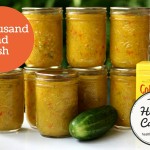
Thousand Island Relish
Ingredients
- 3 kg cucumber (6 pounds / 6 large, before prep)
- 1 kg onion (2 lbs / 6 large, before prep)
- 150 g red bell pepper (finely chopped. Measured after seeding, chopping. 1 cup / 1 large / 5 oz)
- 150 g green bell pepper (finely chopped. Measured after seeding, chopping. 1 cup / 1 large / 5 oz)
- 4 tablespoons pickling salt (OR non-bitter, non-clouding salt sub)
- ½ cup flour (2.5 oz / 70 g)
- 3 tablespoons mustard powder
- 1 ½ teaspoons turmeric
- 1 ½ teaspoons mustard seed
- 1 ½ teaspoons celery seed
- 250 ml water (1 cup / 8 oz)
- 750 ml white vinegar (5% or higher. 3 cups / 24 oz)
- 700 g sugar (white. 3 cups / 24 oz.)
Instructions
- Wash, peel and seed the cucumber and chop it finely.
- Put in very large pot or bowl.
- Peel and chop the onion finely; add to bowl.
- Wash, seed and chop the peppers finely; add to bowl.
- Sprinkle the salt over the vegetable mixture .
- Pour enough cold water over the mixture to cover it; mix with your hands or a sturdy spoon.
- Let stand, covered, for 1 to 2 hours, then drain well.
- In a very large heavy pot, mix together the dry ingredients: the flour, mustard powder, turmeric, mustard seed, and celery seed.
- Now add in the wet ingredients gradually, stirring to make a sauce: the water, the vinegar and the sugar OR the liquid stevia.
- Add in the drained veg, stir.
- Put pot on stove burner, bring to a boil, then lower to a simmer and simmer uncovered for about 30 minutes or until the sauce has thickened.
- Pack hot into quarter-litre (½ US pint / 250 ml / 8 oz) jars.
- Leave 2 cm (½ inch) headspace.
- Debubble, adjust headspace.
- Wipe jar rims.
- Put lids on.
- Process in a water bath or steam canner.
- Process filled jars for 10 minutes; increase time as needed for your altitude.
- Best after at least a month of jar time.
Nutrition
Reference information
How to water bath process.
How to steam can.
When water-bath canning or steam canning, you must adjust the processing time for your altitude (follow the table above.)
For salt substitute, Herbamare Sodium-Free was used.
For stevia, Better Stevia liquid stevia was the stevia used.
More information about Sugar and Salt-Free Canning in general.
Australia and New Zealand vinegar strength special notes.
What is the shelf life of home canned goods?
Recipe notes
- Trim off both ends of cucumbers; this is to get rid of an enzyme that could make your relish go soft.
- To seed the cucumber, cut it lengthwise and drag the tip of a spoon along the centre.
- To chop the cucumber, you can cut the peeled, seeded into chunks, pop in a food processor and use the pulse button.
- For the flour, use plain flour or all-purpose (i.e. don’t use self-rising.) Feel free to cut back a bit on the flour, by up to half, even, for a less thick relish.
- You can use all one colour of a pepper; the two different colours are just for look.
- The purpose of the soaking here is to infuse the vegetable with flavour.
- Instead if the sugar, you could use the same volume amount of Splenda® OR 3 teaspoons liquid stevia.
Recipe source
Thousand Island Relish. Canadian Living Test Kitchen. The Complete Preserving Book. Montreal, Canada: Transcontinental Books. 2012. Page 178.
Note: This recipe is lightly thickened with flour. While it generally isn’t considered safe to thicken home-canned products with flour, the exception is if the recipe has been lab-tested for safety by professionals, as this one has been. So enjoy!
All Canadian Living home canning recipes are lab-tested to meet or exceed Bernardin and USDA standards for quality and safety.
Modifications
Safety Check
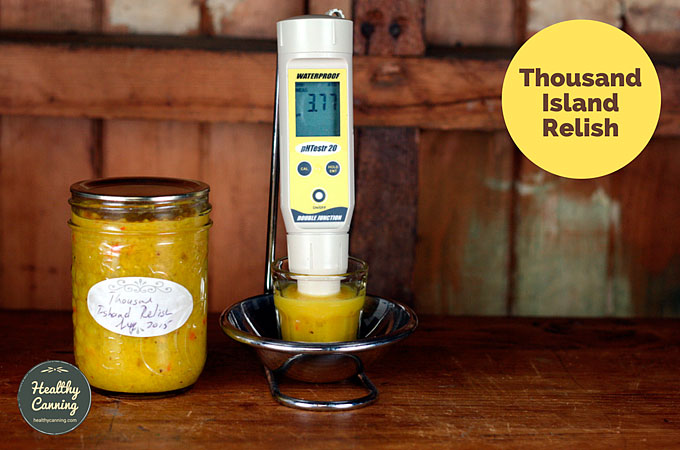
Thousand Island Relish has a pH of 3.77, tested using 25 g solids, 50 ml distilled water. Well below upper safety cut-off of 4.6 pH.
Nutrition information
Regular version
Per 2 tablespoons / 30 ml:
- 44 calories, 79 mg sodium
Sugar and salt-free version
Per 2 tablespoons / 30 ml:
- 16 calories, 2 mg sodium
* Nutrition info provided by https://caloriecount.about.com
* Better Stevia ® is a registered trademark of the NOW Foods Company.
* Herbamare ® is a registered trademark of the A. Vogel Corporation.

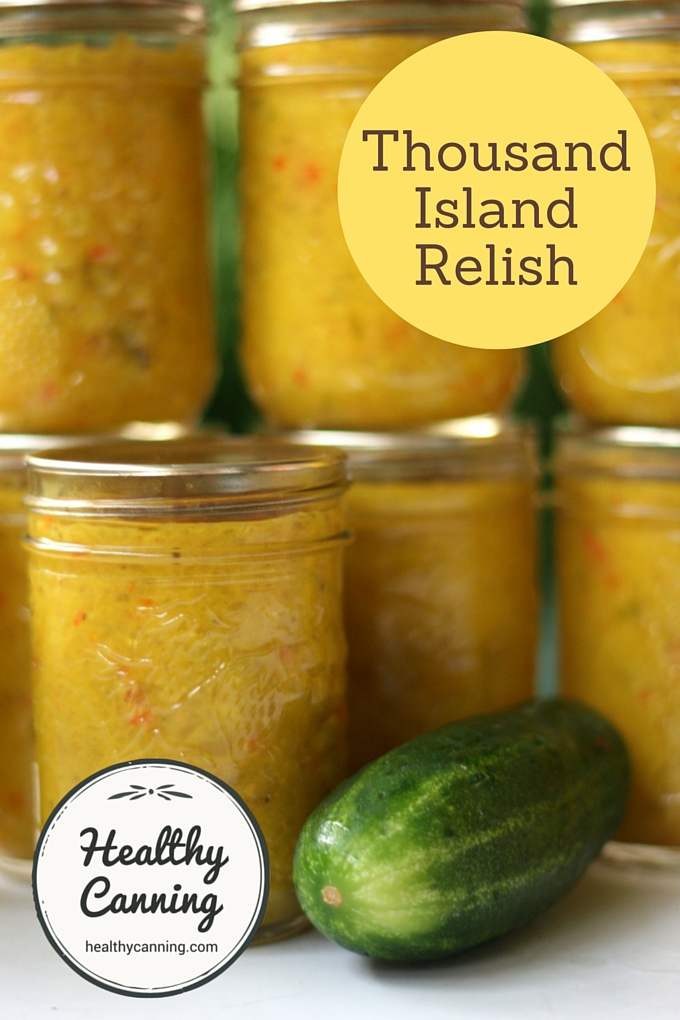

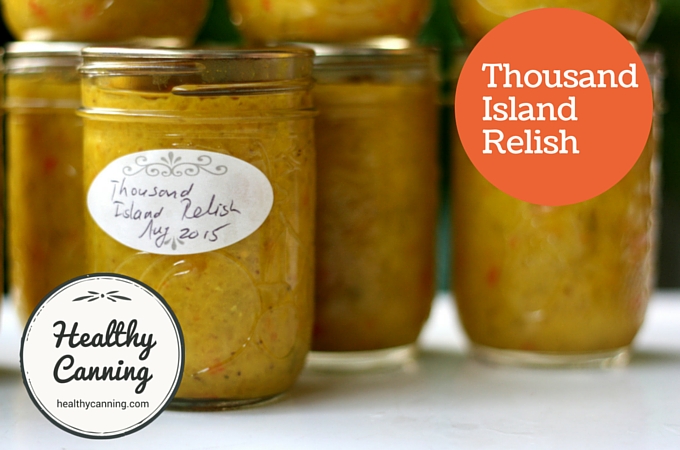
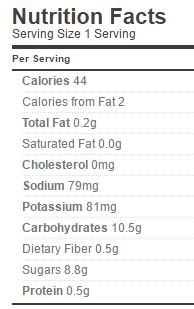
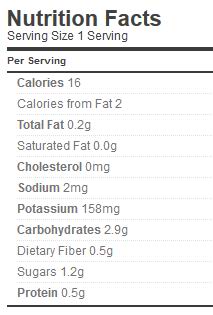
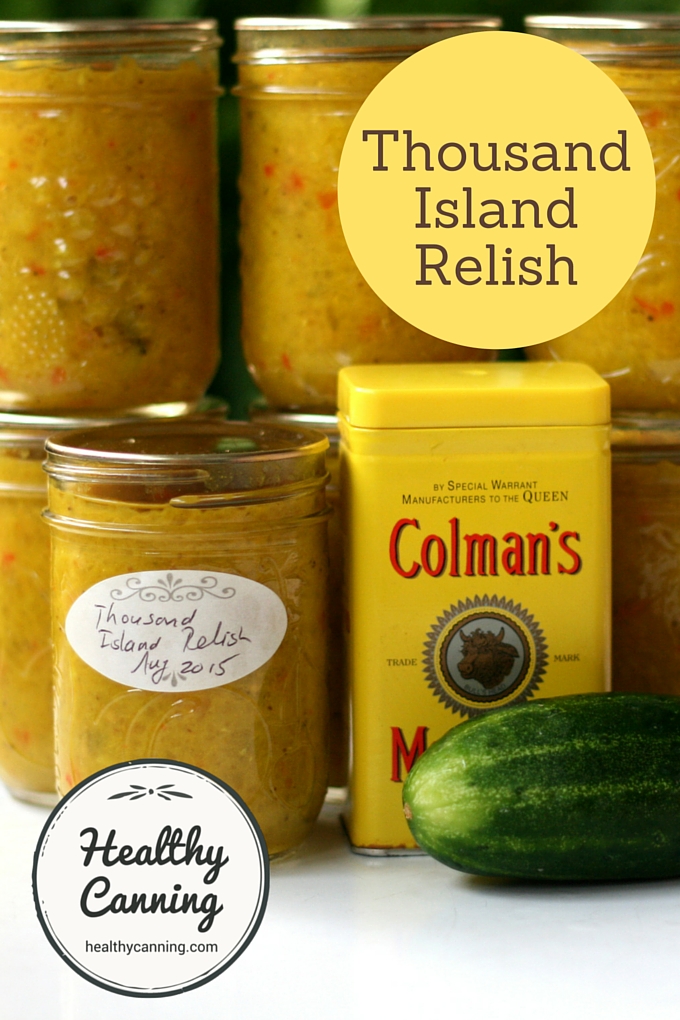
David
Hoping you can clarify a question I have about this recipe.
Step 7 calls for draining the veg. Most other relish recipes I have seen call for draining and rinsing as well. Is that not necessary for this recipe? Is the expectation that some of the salt makes it into the finished product?
Thanks so much! I really appreciate the commitment to safety from this website.
Healthy Canning
Confirming that no rinsing is called for.
Kat
Can you please tell me who tested this recipe and what tests were performed? TY
Healthy Canning
This is covered in paragraph 3 up above on this page.
Sally
Made this over the weekend and thought the flavor was good. Thinking back When draining the veggies do we rinse off the salt, or is it not necessary for this recipe? Just want to check as I’m a newbie to canning
Healthy Canning
Confirming that this recipe does *not* call for rinsing.
Karen Niemi
is it possible to substitute the flour with something else as a thickener. We have a celiac family member and cannot use flour in the relish
Healthy Canning
We’re not qualified to speak on what possible alternatives would be safe, either canning wise, or health wise for that family member. Probably a good idea to just search for another relish recipe to can.
Jill
Is this relish used to make thousand island dressing? If so, how do you make the dressing? Thanks
Healthy Canning
Though it’s from or named after the same area, this relish is a separate food item from the dressing.
Mary Glenister
You can just add a couple tablespoons of this and catsup to salad dressing or mayo. Makes thousand island dressing or (special sauce) for hamburgers. yum. May recipe is old and also has one head of cauliflour and a bunch of celery in the original relish recipe.
For French dressing you can add more catsup and Lea and Perrins sauce and a bit of garlic pounder mayo.
Jessie
How many cups of cucumbers will I have after they are peeled, seeded and finely chopped?
Healthy Canning
Sorry, we didn’t think to get that measurement, though in retrospect it would have been interesting, for sure.
Carly
Is it 6 pounds after the peeled, seeded and chopped cucumbers? I started with 6pounds of cucumbers, after I do all of that it comes to 3 pounds after I cut the ends off and seeds out and weigh it. Thanks
Healthy Canning
Sorry, yes it was 6 lbs before prep. You got it right. That clarification has now been added.
Sally
Canning newbie here – when we drain the veggies do we rinse the salt off, or no? It doesn’t say to rinse, but the last relish recipe I made was adamant about rinsing so just wanted to check. Some instructions often assume we know more than we do so can’t be too careful 🙂 thank you.
Healthy Canning
Confirming that this recipe does *not* call for rinsing.
Jessie
Can this be done in pints?
Healthy Canning
No. The largest tested size is half-pints.
Stacy
Made a few jars of this last year to make sure we loved it. It was gone before the fall. Everyone loved it. Making a full batch right now and can’t wait. Followed exact recipe to the weights. Thanks for sharing.
Madeleine
I am taking a Canadian roadtrip this summer from Maine, through Canada, to Michigan. I have never been across the border before. If I was to visit farmers markets and buy canned goods such as this, am I allowed to take them back across the border if they are unopened??